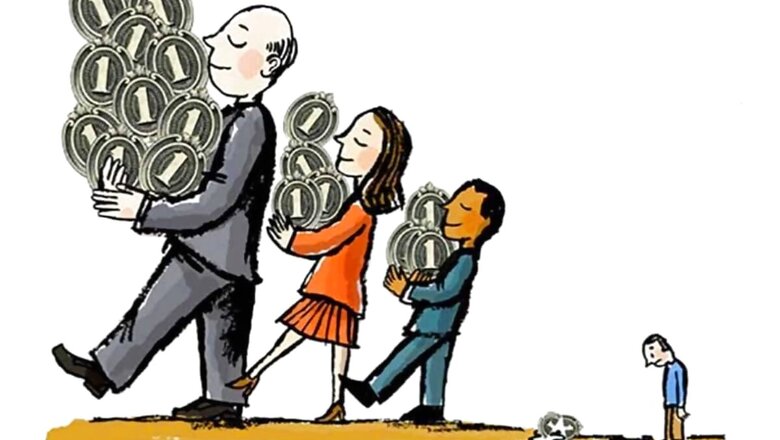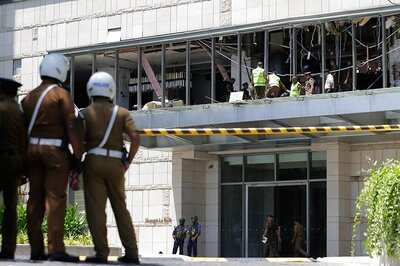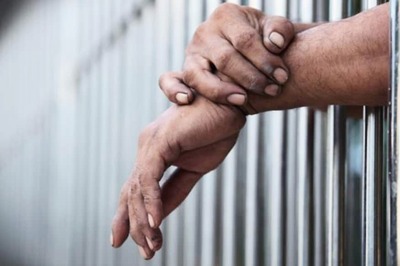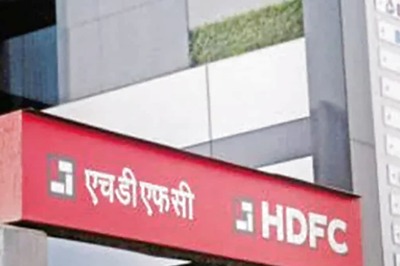
views
For something to be judged as ‘upper’ or ‘lower’, something must inevitably be the ‘middle’, to serve as a baseline for comparison. Metaphorically speaking, the class structure of India seems to be a ‘McMaharaja’, with the top and bottom bread being the upper and lower classes respectively, with a variety of veggies and toppings constituting the middle class. The middle class, in the entirety of the class structure, seems to be a cohesive group, which is only partially correct. Like the
McMaharaja, the filling can be further divided into different veggies, meat and dressings, purposefully illustrative of how the middle class has a number of sub-divisions within it, that are heterogeneous in nature.
Our understanding of ‘rich’ and ‘poor’ as social spaces at the two very ends, facilitates a conceptual need for an intermediary middle class, a location desirable to most. There have been endless debates and attempts to ‘eradicate’ poverty, but what actually takes place is the upliftment of the poor into the lower strata of the middle class, giving rise to a ‘lower middle class’ as a subtype of the middle class in itself. At the end of the day, the rich, middle and poor, all exist in relativity to one another, and if all the poor and poverty as a whole ceased to exist, what would the ‘middle’ be in the middle of?
The history of the ‘creation’ of the Indian middle class can be traced back to colonial rule and their need to ‘manufacture’ a native elite class that could serve to bridge the gap between the foreign colonisers and the indigenous Indian subjects. As a result, English, as a means of communication, medium of educational instruction and subsequent branding as a native elite came about. The middle class is characterised by white-collar occupations, and this very requirement of English as a default mode of communication supposedly seems to guarantee entry into the white-collar job sector, as well as produce a by-product of social etiquette and ‘taste.’ Even by a political yardstick, ideological integration across communities, the length and breadth of the country, castes and classes, takes place via English as a connecting string.
Briefly touching upon the intersection of class and caste, it was originally the upper caste that sought education and detachment from physical labour. The same can be seen in the daily lifestyles of middle-class families, wherein they seek education, both as a means of job security as well as retention of social hierarchy positions. Additionally, the hiring and increasing dependence on domestic help — be it a maid, cook or driver, (since chauffeur sounds too upper class) — is a transformative manifestation of caste structures into class ones. While the middle class is hyper-dependent on domestic help, there still exists an anti-slum attitude. The ‘very urban’ slums we cannot do without, are where our domestic help hails from, yet is never accounted for, as a legitimate part of the metropolitans.
With education gradually opening up to castes beyond just the Brahmins, the hereditary nature of occupations has shifted to skill and knowledge-based allotment, making occupation a distinctly defining criterion of class categorisation. Even those from within the same caste are becoming differentiated amongst themselves by virtue of education, occupation, income and lifestyles, creating the in-house heterogeneity mentioned earlier.
With access to industrial and economic resources and the evolving Indian social structures, the urban-centeredness of a homogeneous middle class began fragmenting. The rural dwellers, who favourably survived in the rural settings through farming, poultry, flour and sugar mills, and transportation of agrarian products, sent their children to cities for education, creating a new division of ‘rural-middle class’, which compounded upon the already existing agrarian middle class.
With individuals from different castes and communities entering a shared social space in the middle class, they acquire not only economic interests and modern lifestyles, but also newfound self-images and social identities. A stable democracy demands a strong middle class as a prerequisite in the post-colonial world, having all judiciary, legislature and bureaucratic sectors populated by those of the middle class. The pyramid-shaped conceptualisation of class domination has now transformed into one that is diamond shaped, with the middle class constituting 50 percent of the Indian population. The educational factor plays out in the middle class being a major pro-democratic force; a statistically large enough organised force that has the capacity to hold its ground to an extent, against elite ideological influence and domination.
The middle class, as a consumer class, is perhaps one of the biggest identifiers. The Centre for the Study of Developing Societies (CSDS) conducted a survey in 1996 and looked at five identity indicators of the middle class, namely — education above high school level, white collar jobs, residence in a house, ownership of assets such as television, water pump, house, car or scooter and self-identification as a member of the middle class. Perhaps this is why, in 2007, the then Tamil Nadu government gifted television sets to families below the poverty line, as a consolatory ‘feeling’ of belonging to the middle class. Material assets are still transferable and can be materially acquired and accounted for, but when it comes to intangible factors such as self-identification, the line between belonging or not belonging to the middle class becomes fuzzy, making it more a state of mind, rather than an economic status or social class.
For decades, perhaps centuries, the middle class may have included the middle and upper levels of clerical workers, those engaged in technical and professional occupations, supervisors and managers, and such self-employed workers as small-scale shopkeepers, businesspersons, and farmers. The middle class has also been referred to as a class of people in the middle of a social hierarchy, often defined by occupation, income, education, or social status. The term has historically been associated with modernity, capitalism and political debate.
Roughly 53 percent of Americans called themselves middle class in a Pew Foundation survey conducted during the early days of the Great Recession. Among them were people making less than $20,000 a year and even people making more than $150,000. Nearly eight in 10 of them agreed that a middle-class lifestyle was harder to maintain then, than it was five years ago. One in four people blamed the government. One in seven blamed oil prices. And one in nine blamed themselves. To conclude, the reputed American demographer Tom Gillaspy, who served as Minnesota’s state demographer for 33 long years before retiring, once said that the definition of the middle class is no longer just about social or economic hierarchies. Gillaspy famously said– “It is more emotional than scientific.” Indeed, the very definition of what constitutes the middle class is now changing and rightfully so.
Yashee Jha, a multi-faceted student, is an avid commentator on various topical issues. Views expressed are personal.
Read all the Latest Opinions here


















Comments
0 comment